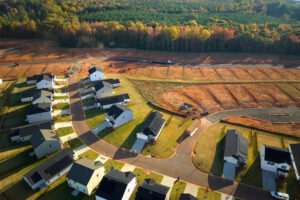 Both the housing market and the home building industry have been somewhat unpredictable over the past few years. While a supply shortage in the housing market is driving up property prices and demand for new construction, an ongoing skilled labor shortage, zoning laws, and rising building costs have created hurdles for home builders. So, what’s the new home building and construction forecast for 2020? Here’s what builders should know about the 2020 predictions, trends and risk factors and how they can increase home sales with structural home warranties.
Both the housing market and the home building industry have been somewhat unpredictable over the past few years. While a supply shortage in the housing market is driving up property prices and demand for new construction, an ongoing skilled labor shortage, zoning laws, and rising building costs have created hurdles for home builders. So, what’s the new home building and construction forecast for 2020? Here’s what builders should know about the 2020 predictions, trends and risk factors and how they can increase home sales with structural home warranties.
Predictions, Trends & Risk Factors
It’s impossible to predict precisely what will happen in 2020. However, by looking closely at the current housing market, demographic shifts, economic trends, and the labor market, home builders can get a better idea of the outlook over the next year.
Current U.S. Housing Market Overview
According to CNBC contributor Diana Olick, home sales in the U.S. dropped in the first quarter of 2019 despite a sizeable dip in mortgage rates. In April, sales were 4.4 percent lower than the previous year. While some predicted that lower mortgage rates would lead to more pending sales, limited inventory and high real estate prices have discouraged some would-be buyers. A report by the National Association of Realtors (NAR) showed pending home sales in September 2019 were up 1.5 percent, marking two months in a row of positive numbers. However, the overall outlook was relatively flat with the four major regions split last month. The Midwest and South recorded gains, but the Northeast and West reported declines in month-over-month contract activity.
Olick explains that existing homes make up close to 90 percent of the total housing market, but “new construction continues to lag historically normal levels of production.” Part of the reason why more homes are currently on the market is that they are taking longer than usual to sell. “As they sit on the market, supply swells. The new supply is not, however, changing forecasts for future sales,” she adds. With that said, industry experts still predict that home sales will continue to rise for the remainder of 2019 and into 2020.
Buyer’s Market vs. Seller’s Market
In some areas of the United States, the housing market is beginning to shift from a seller’s market to a buyer’s market. This means buyers have more decision power due to certain factors such as an uptick in inventory and an increase in the average time homes sit on the market. A rise in inventory in Chicago has led to more favorable conditions for buyers in the Windy City, but other cities –– such as Denver, Seattle, and San Francisco –– face a quickly diminishing supply of residential real estate. According to Brandon Cornett from Home Buying Institute (HBI), it might be too early to predict whether this will be a nationwide trend by next year, but new home builders can “expect to see buyer’s market conditions developing in more cities in 2020.”
Demographics & Economy
Demographic and economic trends are also a major factor in projecting what next year’s new home building and construction industry will look like. Millennials make up a majority of first-time homebuyers with a median age of 33. While there are currently 4.4 million people in this age group, there will be an estimated 4.8 million by 2024, potentially creating a more substantial housing shortage. In addition, many Baby Boomers are choosing to stay in their current homes instead of moving into retirement communities, which also contributes to the housing crisis.
Forbes contributor Bill Conerly notes that income (including disposable income) has been steadily increasing due to low unemployment rates and higher wages. Sam Khater, a chief economist at Freddie Mac, says the industry still expects “stronger home sales and housing starts in the coming months due to favorable market conditions and accelerating wage growth.”
Continued Labor Shortage
An ongoing skilled labor shortage in the construction industry continues to put a damper on residential development. May 2019 statistics released by the NAR show that there are currently over 100,000 fewer seekers of construction jobs than there are openings. At the end of May, there were 404,000 available construction jobs and 294,000 unemployed people seeking positions in the industry. The labor shortage has been a significant factor in holding back new housing starts and delaying completion for residential development projects.
Construction Risk Management Solutions for the Future of Home Building
How can new home builders take a practical look at the 2020 forecast while protecting their bottom line? Forbes contributor Bill Conerly comments that for residential developers who wish to turn a profit while contributing to a solution to the housing crisis, the challenge is to remain “in the ballpark of building just the right amount of new housing.” Builders should also stay aware of the changing demographics of first-time buyers while developing strategies to attract those groups. However, it’s crucial to prepare for the unknown with builder risk management solutions.
Structural Defects & Other Risks
Risk is an unavoidable truth in the new home building industry. In addition to a labor shortage, builders must be ready to respond to potential delays, damages, and costs caused by other variables such as inclement weather, structural defects, tariffs, and zoning rules. Any of these liabilities can be both expensive and difficult to navigate in an already uncertain market. Keep in mind that purchasing real estate is a risk for home buyers as well, and offering structural home warranties can increase buyer confidence.
Home builder warranties and other construction risk management solutions from PWSC can protect both developers and buyers as they head into 2020. Find a sales director in your area to get started.




